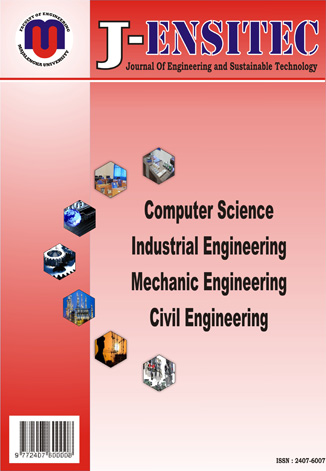STUDI KLASIFIKASI TOPIK BERITA DENGAN ALGORITMA MACHINE LEARNING
DOI:
https://doi.org/10.31949/jensitec.v11i01.12037Abstrak
As a result of the use and access of social media, it also has an impact on increasing the amount of data and information, especially text data. Text has become one of the most natural forms of data that is stored, so that the field of text mining is believed to be an advanced field of data mining. Facts that emerge from research studies that have been conducted show that 80% of company information is presented in text documents. Text mining is a multidisciplinary field, involving information retrieval, text analysis, information extraction, and clustering. The text mining classification method is one technique that can be used to carry out classification. Text classification specifically works to group text documents based on categories, and within the scope of news datasets, categories are generally divided into politics, economics, military, sports and others. Statistical methods are one of the most frequently applied methods in text emotion classification. As a method in statistics, Naive Bayes is a classification algorithm that is easy to understand in text classification. Apart from that, Naïve Bayes has good classification effects and performance for processing large-scale data. The conclusion of this research is, Naïve Bayes gets an accuracy value of 77.78%. Random Forest gets an accuracy of 70.1%. KNN gets an accuracy of 24.88% and SVM gets an accuracy value of 80.60%. Meanwhile, the respective running times are Naïve Bayes 0.046 seconds, Random Forest 150 seconds, KNN 15 seconds, and SVM 0.43 seconds.
Kata Kunci:
knn, naive bayes, random forest, support vector machineUnduhan
Referensi
Y. Ying, T. N. Mursitama, Shidarta and Lohansen, "Effectiveness of the News Text Classification Test Using the Naïve Bayes’ Classification Text Mining Method," in J. Phys.: Conf. Ser. 1764 012105, 2021.
E. D. Bintari, Gunawan and A. Indriani, "Classification of News on “Radar” Tarakan Online Using KNearest Neighbor Method with N-Gram Features," in IOP Conf. Ser.: Mater. Sci. Eng. 676 012008, 2019.
J. P. Haumahu, S. D. H. Permana and Y. Yaddarabullah, "Fake news classification for Indonesian news using Extreme Gradient Boosting (XGBoost)," in IOP Conf. Ser.: Mater. Sci. Eng. 1098 052081, 2021.
P. Yu, V. Y. Cui and J. Guan, "Text Classification by using Natural Language Processing," in J. Phys.: Conf. Ser. 1802 042010, 2021.
I. M. Rabbimov and S. S. Kobilov, "Multi-Class Text Classifcation of Uzbek News Articles using Machine Learning," in J. Phys.: Conf. Ser. 1546 012097, 2020.
X. Wu and J. Chen, "Text Classification on Large Scale Chinese News Corpus using Character-level Convolutional Neural Network," in J. Phys.: Conf. Ser. 1693 012171, 2020.
J. Li and H. Zhu, "A Practical Application for Text-Based Sentiment Analysis Based on Bayes-LSTM Model," in J. Phys.: Conf. Ser. 1631 012035, 2020.
D. D. Saputra, W. Gata, N. K. Wardhani, K. S. Parthama, H. Setiawan, S. Budilaksono, D. Yogatama, A. Hadiyatna, E. P. Purnamasari, B. Pratama and D. Novianti, "Optimization Sentiments of Analysis from Tweets in myXLCare using Naïve Bayes Algorithm and Synthetic Minority Over Sampling Technique Method," in J. Phys.: Conf. Ser. 1471 012014, 2020.
Syahriani, A. A. Yana and T. Santoso, "Sentiment Analysis Of Facebook Comments On Indonesian Presidential Candidates Using The Naive Bayes Method," in J. Phys.: Conf. Ser. 1641 012012, 2020.
Diterbitkan
Cara Mengutip
Terbitan
Bagian
Lisensi
Hak Cipta (c) 2024 Guruh Wijaya, Dudi Irawan, Zainul Arifin, Hardian Oktavianto, Miftahur Rahman, Ginanjar Abdurrahman

Artikel ini berlisensiCreative Commons Attribution-ShareAlike 4.0 International License.
An author who publishes in the J-ENSITEC (Journal of Engineering and Sustainable Technology) agrees to the following terms:
- Author retains the copyright and grants the journal the right of first publication of the work simultaneously licensed under the Creative Commons Attribution-ShareAlike 4.0 License that allows others to share the work with an acknowledgment of the work's authorship and initial publication in this journal
- The author is able to enter into separate, additional contractual arrangements for the non-exclusive distribution of the journal's published version of the work (e.g., post it to an institutional repository or publish it in a book) with the acknowledgment of its initial publication in this journal.
- The author is permitted and encouraged to post his/her work online (e.g., in institutional repositories or on their website) prior to and during the submission process, as it can lead to productive exchanges, as well as earlier and greater citation of the published work







